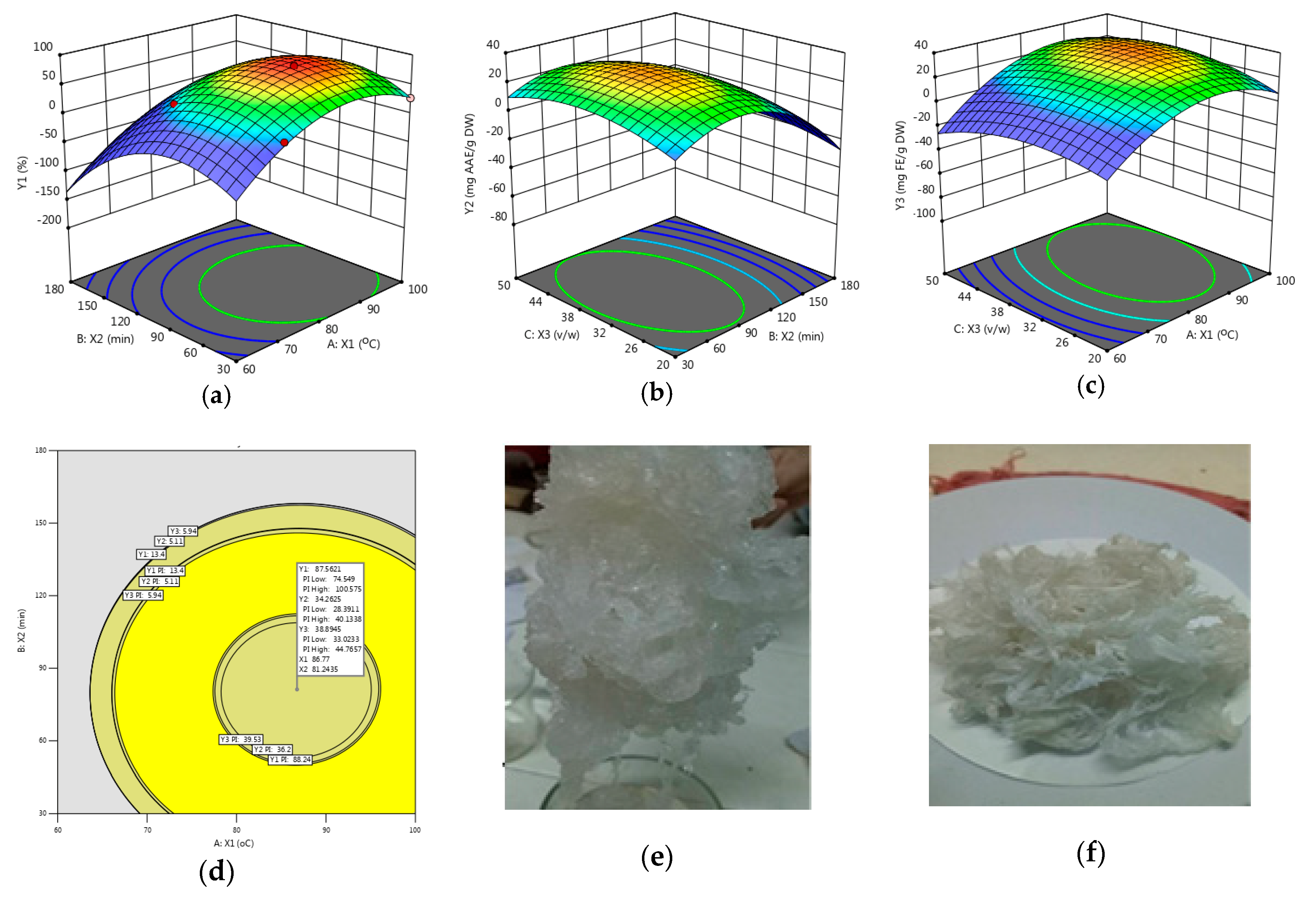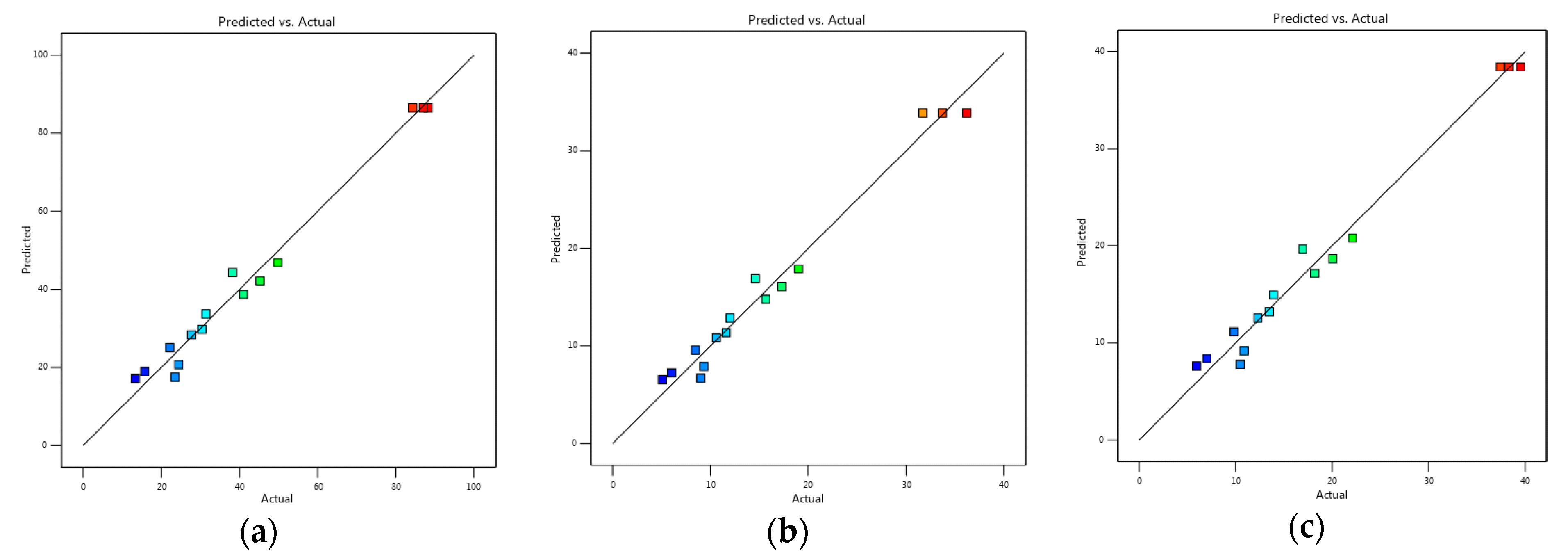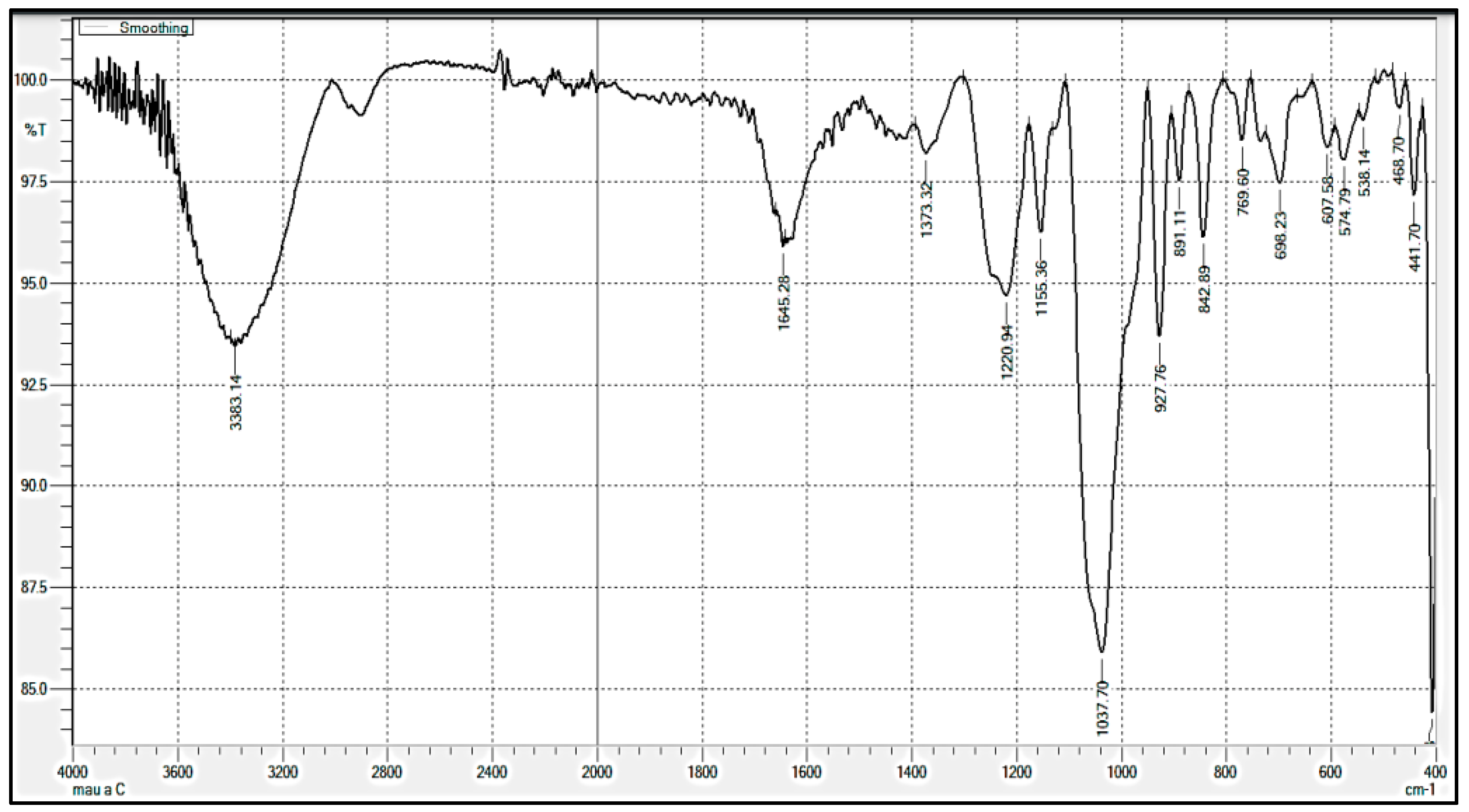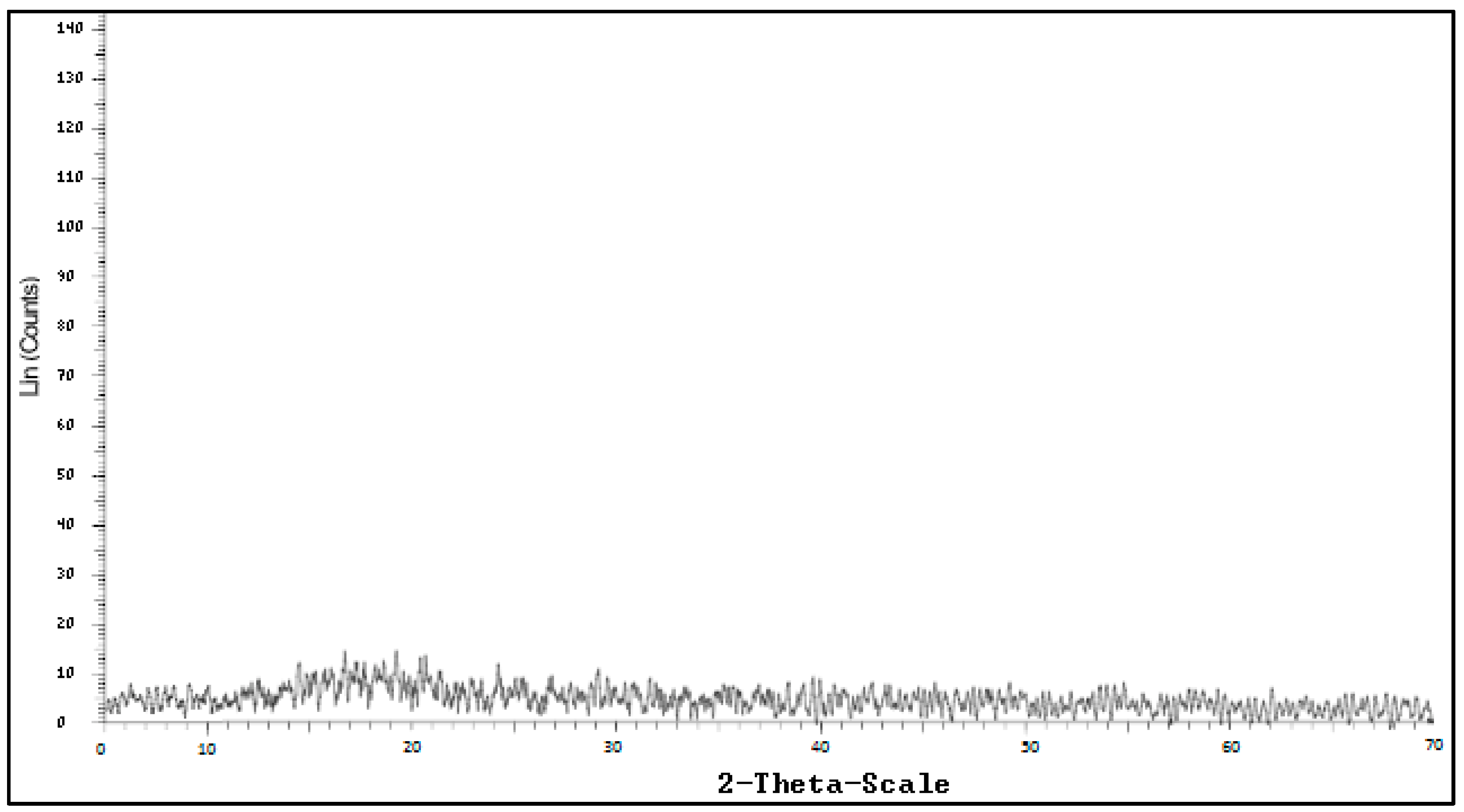Carrageenan of Red Algae Eucheuma gelatinae: Extraction, Antioxidant Activity, Rheology Characteristics, and Physicochemistry Characterization
Abstract
:1. Introduction
2. Results
2.1. Extraction of Antioxidant Carrageenan
2.1.1. Purity Carrageenan Content
2.1.2. Antioxidant Activity
Total Antioxidant Activity
Reducing Power Activity
2.1.3. Correlation between Carrageenan Content and Antioxidant Activity
2.2. Optimization of Antioxidant Carrageenan
2.2.1. Analysis of Optimization Model
2.2.2. Test of Optimization Model by the Experiment
2.3. Characteristics of Rheology and Physical-Chemistry of Antioxidant Carrageenan
2.3.1. Rheological Characteristic of Antioxidant Carrageenan
2.3.2. Physical-Chemistry Characteristics of Antioxidant Carrageenan
3. Discussion
4. Materials and Methods
4.1. Source of the Plant Material
4.2. Sample Preparation
4.3. Extraction of Carrageenan
4.4. Optimization of Carrageenan Extraction
4.5. Determination of the Content and the Extraction Efficiency of Carrageenan
4.5.1. Purity Carrageenan Content
4.5.2. Extraction Efficiency of Carrageenan
4.6. Detemination of Antioxidant Activity
4.6.1. Total Antioxidant Activity
4.6.2. Reducing Power Activity
4.7. Determination of Rheological Characteristics
4.7.1. Gell Strength
4.7.2. Intrinsic Viscosity
4.8. Determination of Physic-Chemistry Characterization
4.8.1. Sugar Compositions
4.8.2. Molecular Weight
4.8.3. Functional Groups
4.8.4. Crystal Structure
4.9. Statistical Analysis
5. Conclusions
Supplementary Materials
Author Contributions
Funding
Institutional Review Board Statement
Informed Consent Statement
Data Availability Statement
Acknowledgments
Conflicts of Interest
References
- Bixler, H.; Porse, H. A decade of change in the seaweed hydrocolloids industry. J. Appl. Phycol. 2011, 23, 321–335. [Google Scholar] [CrossRef]
- FAO. The state of the world fisheries and aquaculture 2020. Sustain. Action Rome 2020, 244. [Google Scholar] [CrossRef]
- Brakel, J.; Sibonga, R.C.; Dumilag, R.V.; Montalescot, V.; Campbell, I.; Cottier-Cook, E.J.; Ward, G.; Le, M.V.; Liu, T.; Msuya, F.E.; et al. Exploring, harnessing and conserving marine genetic resources towards a sustainable seaweed aquaculture. Plants People Planet 2021, 3, 337–349. [Google Scholar] [CrossRef]
- FAO. The global status of seaweed production, trade and utilization. Globefish Res. Programme 2018, 24, 124. [Google Scholar]
- Available online: https://www.fao.org/3/x5819e/x5819e06.htm (accessed on 30 November 2016).
- Gómez-Ordóñez, E.; Jiménez-Escrig, A.; Rupérez, P. Bioactivity of sulfated polysaccharides from the edible red seaweed Mastocarpus stellatus. Bioact. Carbohydr. Diet. Fibre 2014, 3, 29–40. [Google Scholar] [CrossRef] [Green Version]
- Besednova, N.; Zaporozhets, T.; Kuznetsova, T.; Makarenkova, I.; Fedyanina, L.; Kryzhanovsky, S.; Malyarenko, O.; Ermakova, S. Metabolites of seaweeds as potential agents for the prevention and therapy of influenza infection. Mar. Drugs 2019, 17, 373. [Google Scholar] [CrossRef] [Green Version]
- Necas, J.; Bartosikova, L. Carrageenan: A review. Vet. Med. 2013, 58, 187–205. [Google Scholar] [CrossRef] [Green Version]
- Mingjin, Z.; Liming, G.; Yongbo, L.; Yaxin, Zi.; Xinying, Li.; Defu, L.; Changdao, M. Preparation, characterization and antibacterial activity of oxidized κ–carrageenan. Carbohydr. Polym. 2017, 174, 1051–1058. [Google Scholar] [CrossRef]
- Ratih, P.; Se-Kwon, K. Biological Activities of Carrageenan. Adv. Food Nutr. 2014, 72, 113–124. [Google Scholar] [CrossRef]
- Maxim, K.; Vladlena, T.; Aleksandra, K.; Maria, B.; Rodion, K.; Ekaterina, L.; Igor, B.; Yuri, K. Antitumor potential of carrageenans from marine red algae. Carbohydr. Polym. 2020, 246, 116568. [Google Scholar] [CrossRef]
- Eduardas, C.; Aleksandra, A.; Kalitnik, Y.A.K.; Manoj, S.G.M.R.; Anant, A.; Anna, O.K. Immunomodulating properties of carrageenan from Tichocarpus crinitus. Inflammation 2020, 43, 1387–1396. [Google Scholar]
- Xia, Q.; Wenwen, Z. Antihyperglycemic and antihyperlipidemic effects of low-molecular-weight carrageenan in rats. Open Life Sci. 2018, 13, 379–384. [Google Scholar] [CrossRef]
- Tobacman, J.K. Review of harmful gastrointestinal effects of carrageenan in animal experiments. Environ. Health Perspect. 2001, 109, 983–994. [Google Scholar] [CrossRef]
- Edisson-Mauricio, P.-Q.; Roberto, R.-C.; María-Dolores, V. Carrageenan: Drug delivery systems and other biomedical applications. Mar. Drugs 2020, 18, 583–622. [Google Scholar] [CrossRef]
- Tarman, U.S.; Joko, S.; Linawati, H. Carrageenan and its enzymatic extraction. In Kustiariyah Encyclopedia of Marine Biotechnology: Five Volume Set, 1st ed.; John Wiley & Sons Ltd.: Hoboken, NJ, USA, 2020. [Google Scholar]
- Andi, H.; Meta, M.; Amran, L.; Metusalach, M. Extraction of carrageenan from Eucheuma spinosum using ohmic heating: Optimization of extraction conditions using response surface methodology. Food Sci. Technol. 2021, 41, 928–937. [Google Scholar]
- Zainab, M.A.-N.; Ahmed, A.-A.; Insaaf, A.-M. The effect of extraction conditions on chemical and thermal characteristics of kappa-carrageenan extracted from Hypnea bryoides. J. Mar. Sci. 2019, 2019, 5183261. [Google Scholar] [CrossRef] [Green Version]
- Siti, M.; Widiyastuti, W.; Hideki, K.; Sugeng, W.; Motonobu, G. Pressurized hot water extraction of carrageenan and phenolic compounds from Eucheuma cottonii and Gracilaria sp.: Effect of extraction conditions. ARPN J. Eng. Appl. 2019, 14, 3113–3123. [Google Scholar]
- Mariel, G.T.; Lucille, V.A.; Virgilio, D.E.; Drexel, H.C. Ultrasound-assisted depolymerization of kappa-carrageenan and characterization of degradation product. Ultrason. Sonochem. 2021, 73, 105540. [Google Scholar] [CrossRef]
- Vázquez-Delfín, E.; Robledo, D.; Freile-Pelegrín, Y. Microwave-assisted extraction of the Carrageenan from Hypnea musciformis (Cystocloniaceae, Rhodophyta). J. Appl. Phycol. 2014, 26, 901–907. [Google Scholar] [CrossRef]
- Deng, C.-M.; Wu, Z.-J.; He, L.-Z.; Zhang, G.-G.; Wu, Y.-L.; Wen, Y.-M.; Kang, X.-H. Technological optimization of alkali pretreatment in the carrageenan extraction from Eucheuma gelatinae. Sci. Technol. Food Ind. 2017, 22, 178–183. [Google Scholar] [CrossRef]
- Tran, T.T.V.; Vo, M.N.H.; Cao, T.T.H.; Phan, T.H.T.; Tran, M.D.; Quach, T.M.T. Structural characteristics and biological activity of sulfated polysaccharide from red algae Betaphycus gelatinus. Vietnam J. Sci. Technol. 2020, 58, 252–260. [Google Scholar]
- Vanessa, W.; Sabrina, M.D.C.; Paulo, J.O.; Leila, H.; Pedro, L.M.B. Optimization of the extraction of carrageenan from Kappaphycus alvarezii using response surface methodology. Food Sci. Technol. 2012, 32, 812–818. [Google Scholar]
- Chen, F.; Peng, J.; Lei, D.; Liu, J.; Zhao, G. Optimization of genistein solubilization by κ-carrageenan hydrogel using response surface methodology. Food Sci. Hum. Wellness 2013, 2, 124–131. [Google Scholar] [CrossRef] [Green Version]
- Joseph, W.; Bolton, J.J.; Derek, K.; Lincoln, R. Seasonal changes in carrageenan yield and gel properties in three commercial eucheumoids grown in southern Kenya. Bot. Mar. 2006, 49, 208–215. [Google Scholar]
- Nishinari, K.; Watase, M. Effects of sugars and polyols on the gel-sol transition of kappa-carrageenan gels. Thermochim. Acta 1992, 206, 149–162. [Google Scholar] [CrossRef]
- Ahmed, A.-A.; Pothiraj, C.; Abdullah, A.-M.; Insaaf, A.-M.; Mohammad, S.R. Characterization of red seaweed extracts treated by water, acid and alkaline solutions. Int. J. Food Eng. 2018, 14, 1–9. [Google Scholar]
- Pereira, L. Identification of phycocolloids by vibrational spectroscopy. In World Seaweed Resources—An Authoritative Reference System; Critchley, A.T., Ohno, M., Largo, D.B., Eds.; ETI Information Services Ltd., UNESCO: Paris, France, 2006. [Google Scholar]
- Greer, C.W.; Yaphe, W. Characterization of hybrid (Beta-Kappa-Gamma) carrageenan from Eucheuma gelatinae J. Agardh (Rhodophyta, Solieriaceae) using carrageenases, infrared and 13C-nuclear magnetic resonance spectroscopy. Bot. Mar. 1984, 27, 473–478. [Google Scholar] [CrossRef]
- Li-Hwa, L.; Masakuni, T.; Fujiya, H. Isolation and characterization of ι-carrageenan from Eucheuma serra (Togekirinsai). J. Appl. Glycosci. 2000, 47, 303–310. [Google Scholar]
- Fang, J.; Fowler, P.; Sayers, C.; Williams, P. The chemical modification of a range of starches under aqueous reaction conditions. Carbohydr. Polym. 2004, 55, 283–289. [Google Scholar] [CrossRef]
- Aimei, W.; Nahidul, I.M.; Xiaojuan, Q.; Hongxin, W.; Yaoyao, P.; Chaoyang, M. Purification, identification, and characterization of D-galactose-6-sulfurylase from marine algae (Betaphycus gelatinus). Carbohydr. Res. 2014, 388, 94–99. [Google Scholar]
- Prieto, P.; Pineda, M.; Aguilar, M. Spectrophotometric quantitation of antioxidant capacity through the formation of a phosphomolybdenum complex: Specific application to the determination of vitamin E. Anal. Biochem. 1999, 269, 337–341. [Google Scholar] [CrossRef]
- Zhu, Q.Y.; Hackman, R.M.; Ensunsa, J.L.; Holt, R.R.; Keen, C.L. Antioxidative activities of oolong tea. J. Agric. Food Chem. 2002, 50, 6929–6934. [Google Scholar] [CrossRef]






| Std | pH | Extracting Temperature (°C) | Extracting Time (min) | Solvent-to-algae Ratio (v/w) | Purity Carrageenan Content (%, DW) | Total Antioxidant Activity (mg Ascorbic Acid Equivalent/g DW) | Reducing Power Activity (mg FeSO4 Equivalent/g DW) |
|---|---|---|---|---|---|---|---|
| I | 7 | 80 | 60 | 30/1 | 36.09 ± 1.21 a | 24.58 ± 1.15 a | 26.75 ± 1.98 a |
| 8 | 80 | 60 | 30/1 | 34.57 ± 1.42 a | 19.73 ± 2.01 b | 23.29 ± 2.44 ac | |
| 9 | 80 | 60 | 30/1 | 27.28 ± 1.03 b | 15.62 ± 2.19 b | 27.84 ± 2.71 a | |
| 10 | 80 | 60 | 30/1 | 23.41 ± 1.27 c | 10.04 ± 1.68 c | 20.61 ± 2.52 bc | |
| II | 7 | 70 | 60 | 30/1 | 33.77 ± 1.55 a | 19.32 ± 1.92 a | 20.57 ± 2.03 a |
| 7 | 80 | 60 | 30/1 | 36.09 ± 1.47 ab | 24.58 ± 1.15 b | 26.75 ± 1.98 b | |
| 7 | 90 | 60 | 30/1 | 38.58 ± 1.69 b | 27.29 ± 2.75 bc | 29.52 ± 3.01 b | |
| 7 | 100 | 60 | 30/1 | 39.62 ± 1.82 bc | 29.31 ± 2.48 c | 30.59 ± 3.26 b | |
| III | 7 | 90 | 30 | 30/1 | 32.45 ± 1.62 a | 19.05 ± 2.23 a | 23.17 ± 1.78 a |
| 7 | 90 | 60 | 30/1 | 38.58 ± 1.69 b | 27.29 ± 2.75 b | 29.52 ± 3.01 b | |
| 7 | 90 | 90 | 30/1 | 41.02 ± 3.52 b | 28.58 ± 3.10 b | 30.09 ± 2.67 b | |
| 7 | 90 | 120 | 30/1 | 39.52 ± 2.11 b | 30.76 ± 3.21 b | 32.68 ± 3.24 b | |
| IV | 7 | 90 | 90 | 20/1 | 30.14 ± 2.38 a | 20.37 ± 1.92 a | 25.73 ± 2.75 a |
| 7 | 90 | 90 | 30/1 | 41.02 ± 3.52 b | 28.58 ± 3.10 b | 30.09 ± 2.67 ab | |
| 7 | 90 | 90 | 40/1 | 42.68 ± 2.37 b | 29.72 ± 3.22 b | 34.67 ± 2.78 bc | |
| 7 | 90 | 90 | 50/1 | 41.94 ± 3.05 b | 30.04 ± 2.57 b | 36.25 ± 3.01 cd |
| Std | X1 | X2 | X3 | Y1 | Y2 | Y3 |
|---|---|---|---|---|---|---|
| 1 | 70 | 30 | 35 | 23.56 | 9.02 | 10.48 |
| 2 | 100 | 30 | 35 | 27.74 | 10.60 | 12.30 |
| 3 | 70 | 120 | 35 | 30.40 | 11.61 | 13.48 |
| 4 | 100 | 120 | 35 | 38.24 | 14.59 | 16.94 |
| 5 | 70 | 75 | 20 | 22.18 | 8.47 | 9.83 |
| 6 | 100 | 75 | 20 | 24.49 | 9.35 | 10.87 |
| 7 | 70 | 75 | 50 | 13.40 | 5.11 | 5.94 |
| 8 | 100 | 75 | 50 | 49.79 | 19.01 | 22.11 |
| 9 | 85 | 30 | 20 | 15.82 | 6.04 | 7.00 |
| 10 | 85 | 120 | 20 | 41.01 | 15.66 | 18.19 |
| 11 | 85 | 30 | 50 | 31.42 | 12.00 | 13.92 |
| 12 | 85 | 120 | 50 | 45.28 | 17.30 | 20.07 |
| 13 | 85 | 75 | 35 | 88.24 | 33.71 | 37.43 |
| 14 | 85 | 75 | 35 | 86.97 | 31.72 | 39.53 |
| 15 | 85 | 75 | 35 | 84.30 | 36.20 | 38.32 |
| Source | Response Surface Y1 | Response Surface Y2 | Response Surface Y3 | ||||||
|---|---|---|---|---|---|---|---|---|---|
| p-Value | CE | SE | p-Value | CE | SE | p-Value | CE | SE | |
| Model | 0.0007 | 74.17 | 3.02 | 0.0014 | 28.93 | 1.36 | 0.0008 | 32.94 | 1.36 |
| x1 − X1 | 0.0004 | 37.02 | 4.47 | 0.0008 | 14.51 | 2.02 | 0.0004 | 16.44 | 2.02 |
| x2 − X2 | 0.0018 | −44.98 | 7.45 | 0.0030 | −18.11 | 3.36 | 0.0019 | −20.04 | 3.36 |
| x3 − X3 | 0.9527 | −0.1796 | 2.88 | 0.9606 | −0.0675 | 1.30 | 0.9521 | −0.0821 | 1.30 |
| x1x2 | 0.7575 | 2.03 | 6.23 | 0.7932 | 0.7778 | 2.81 | 0.7591 | 0.9111 | 2.81 |
| x1x3 | 0.0288 | 11.36 | 3.74 | 0.0499 | 4.34 | 1.69 | 0.0305 | 5.04 | 1.69 |
| x2x3 | 0.3590 | −4.72 | 4.68 | 0.4325 | −1.80 | 2.11 | 0.3652 | −2.10 | 2.11 |
| x12 | 0.0001 | −55.50 | 5.19 | 0.0002 | −21.94 | 2.34 | 0.0001 | −24.65 | 2.34 |
| x22 | 0.0003 | −70.28 | 8.11 | 0.0006 | −28.00 | 3.66 | 0.0004 | −31.28 | 3.66 |
| x32 | 0.0002 | −27.82 | 2.92 | 0.0004 | −11.05 | 1.32 | 0.0002 | −12.37 | 1.32 |
| Input Factor (Independent Variable) | Code Variable | ||
|---|---|---|---|
| −1 | 0 | 1 | |
| Extracting temperature (X1, °C) | 70 | 85 | 100 |
| Extracting time (X2, minutes) | 30 | 75 | 120 |
| Solvent-to-material ratio (X3, v/w) | 20 | 35 | 50 |
| Std | Actual Variable | Coded Variable | Target Function | ||||||
|---|---|---|---|---|---|---|---|---|---|
| X1 | X2 | X3 | x1 | x2 | x3 | Y1 | Y2 | Y3 | |
| 1 | 70 | 30 | 35 | −1 | −1 | 0 | Yij | ||
| 2 | 100 | 30 | 35 | +1 | −1 | 0 | |||
| 3 | 70 | 120 | 35 | −1 | +1 | 0 | |||
| 4 | 100 | 120 | 35 | +1 | +1 | 0 | |||
| 5 | 70 | 75 | 20 | −1 | 0 | −1 | |||
| 6 | 100 | 75 | 20 | +1 | 0 | −1 | |||
| 7 | 70 | 75 | 50 | −1 | 0 | +1 | |||
| 8 | 100 | 75 | 50 | +1 | 0 | +1 | |||
| 9 | 85 | 30 | 20 | 0 | −1 | −1 | |||
| 10 | 85 | 120 | 20 | 0 | +1 | −1 | |||
| 11 | 85 | 30 | 50 | 0 | −1 | +1 | |||
| 12 | 85 | 120 | 50 | 0 | +1 | +1 | |||
| 13 | 85 | 75 | 35 | 0 | 0 | 0 | |||
| 14 | 85 | 75 | 35 | 0 | 0 | 0 | |||
| 15 | 85 | 75 | 35 | 0 | 0 | 0 | |||
Publisher’s Note: MDPI stays neutral with regard to jurisdictional claims in published maps and institutional affiliations. |
© 2022 by the authors. Licensee MDPI, Basel, Switzerland. This article is an open access article distributed under the terms and conditions of the Creative Commons Attribution (CC BY) license (https://creativecommons.org/licenses/by/4.0/).
Share and Cite
Ha, H.T.; Cuong, D.X.; Thuy, L.H.; Thuan, P.T.; Tuyen, D.T.T.; Mo, V.T.; Dong, D.H. Carrageenan of Red Algae Eucheuma gelatinae: Extraction, Antioxidant Activity, Rheology Characteristics, and Physicochemistry Characterization. Molecules 2022, 27, 1268. https://doi.org/10.3390/molecules27041268
Ha HT, Cuong DX, Thuy LH, Thuan PT, Tuyen DTT, Mo VT, Dong DH. Carrageenan of Red Algae Eucheuma gelatinae: Extraction, Antioxidant Activity, Rheology Characteristics, and Physicochemistry Characterization. Molecules. 2022; 27(4):1268. https://doi.org/10.3390/molecules27041268
Chicago/Turabian StyleHa, Hoang Thai, Dang Xuan Cuong, Le Huong Thuy, Pham Thanh Thuan, Dang Thi Thanh Tuyen, Vu Thi Mo, and Dinh Huu Dong. 2022. "Carrageenan of Red Algae Eucheuma gelatinae: Extraction, Antioxidant Activity, Rheology Characteristics, and Physicochemistry Characterization" Molecules 27, no. 4: 1268. https://doi.org/10.3390/molecules27041268
APA StyleHa, H. T., Cuong, D. X., Thuy, L. H., Thuan, P. T., Tuyen, D. T. T., Mo, V. T., & Dong, D. H. (2022). Carrageenan of Red Algae Eucheuma gelatinae: Extraction, Antioxidant Activity, Rheology Characteristics, and Physicochemistry Characterization. Molecules, 27(4), 1268. https://doi.org/10.3390/molecules27041268






